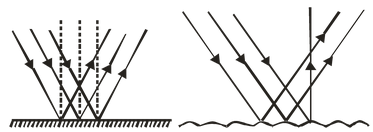REFLECTION OF LIGHT
Light of Class 9
REFLECTION OF LIGHT
When a beam of light falls on any surface, a part of that is sent back into the same medium from which it is coming. This phenomenon is known at the reflection of light.
Reflection of light is of two types:

REGULAR REFLECTION AND IRREGULAR REFLECTION
When light is incident on an interface between two transparent optical media such as between air and glass or between water and glass four things can happen to the incident light
- It can be partly or totally reflected at the interface.
- It can be scattered in random directions at the interface.
- It can be partly transmitted via refraction at the interface and enter thesecond medium.
- It can be partly absorbed in either medium.
REGULAR REFLECTION
Reflection is thechange in direction of a wave front at an interface between two different media so that the wave front returns into the medium from which it originated. Common examples include the reflection of light,sound and water waves. The law of reflection says that for specular reflection the angle at which the wave is incident on the surface equals the angle at which it is reflected. Mirrors exhibit specular reflection. Diffuse reflection/irregular reflection is there flection of light from a surface such that an incident rayis reflected at many angles rather than at just one angle as in the case of specular reflection.
A surface built from a non-absorbing powder such asplaster, or from fibers such as paper, or from apolycrystallinematerial such as whitemarble, reflects light diffusely with great efficiency. Many common materials exhibit a mixture of specular and diffuse reflection.
The visibility of objects, excluding light-emitting ones, is primarily caused by diffuse reflection of light: it is diffusely-scattered light that forms the image of the object in the observer's eye.
In our introductory study of geometrical optics we shall consider only smooth surfaces that give rise to specular (regular, geometric) reflections and ignore ragged, uneven surfaces that give rise to diffuse (irregular) reflections


Related Topics
- Introduction Light
- REFLECTION OF LIGHT
- LAWS OF REFLECTION
- Some Important Terms Related To Spherical Mirrors
- IMPORTANT CONCEPT
- REFRACTION OF LIGHT
- Mind Map
- SOME IMPORTANT TERMS RELATED WITH LIGHT
- Some Important Terms Used In The Reflection Of Light
- IMAGES
- PLANE MIRROR
- MIRROR FORMULA
- LINEAR MAGNIFICATION PRODUCED BY MIRRORS
- Solved questions
- Exercise 1
- Exercise 2
- Exercise 3
- Exercise 4 (True and False)
- Exercise 5 (Subjective)









